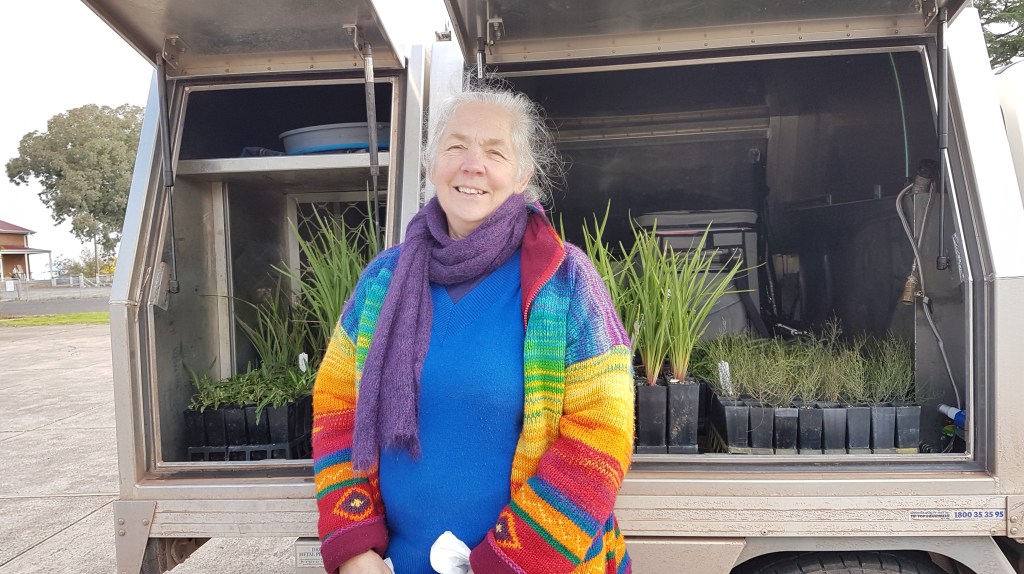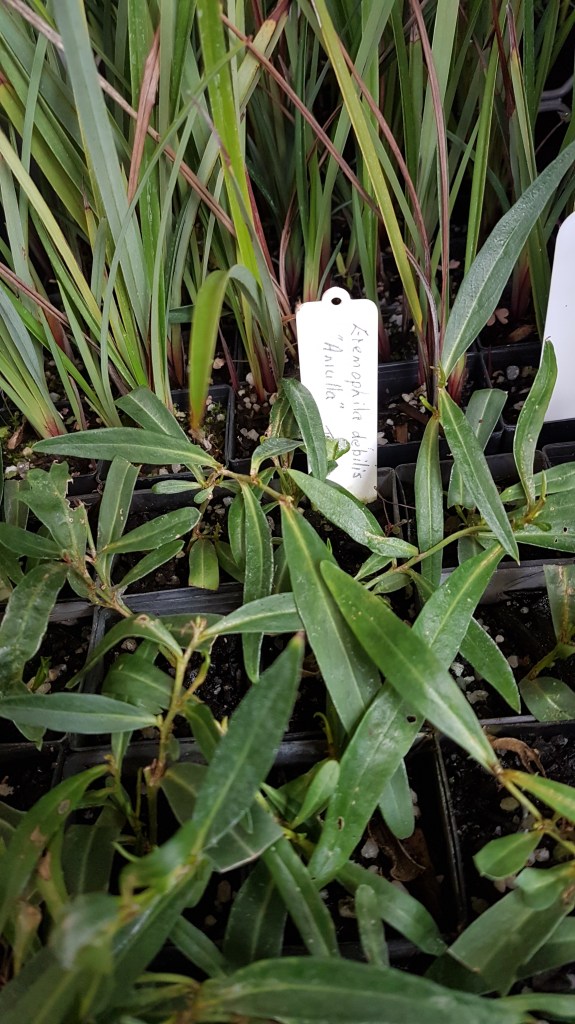Mid Lachlan Landcare
supporting sustainable agriculture and restoring the environment
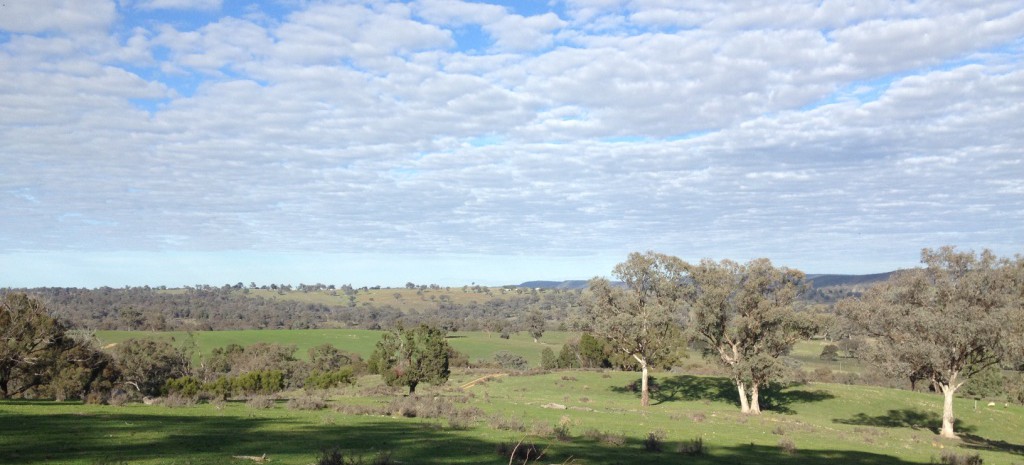
Community Purchase – Amulla or Winter Apple

Thanks to everyone who got behind our trial Box Gum Grassy Woodland groundcover purchase. I hope your groundcovers grow well and reproduce for the future.
It was awesome of Oz Plants and the Weddin Community nursery to try growing these to order for us. As anticipated there were some unsuccessful germinations but recently an extra 2 species have started coming up and these should be ready late Winter/early Spring. Overall we ended up with 7 of the 11 species growing.
You can check out all the species we tried here in our original post. It includes links to descriptions of each species which are all important species in our Box Gum Grassy Woodlands.
I thought we might focus on Amulla or Winter Apple (Eremophila debilis) in this post. My first introduction to it was when I was out exploring a TSR (travelling stock reserve) and it really struck me. It has these bright pink fruit during the Winter months that must be important to plenty of native species. Now that I have had it planted in my garden for a few years I have noticed the Eastern Rosella’s and even the odd King Parrot that look to be feeding on the fruit.
This plant is frost tolerant and is described as drought hardy. I haven’t given mine any extra care and they are spreading well and have even germinated a couple of new ones.
They are edible but I find them a bit on the bitter side with quite a large seed and not much flesh. They are described as ‘Small green fruits approximately 8mm in size that appear in autumn/winter either turning white or pink when ripe. The fruit has an appearance of a tiny apple with a similar crispy texture and sweet taste.’
I purchased about 30 of them during this community opportunity and I am in the process of planting them in some of my revegetation sites on the farm. Can’t wait to see how they go.
Apparently Amulla is not unpalatable to stock and can be heavily grazed at times even with it’s low growth-habit. It is not a common species but this could be due to the fact that it is palatable and has now been grazed out of many sites where it may have previously grown. Each plant can live for 10-20 years, which is amazing, and one plant will cover an area of about a square meter in a couple of years.
The Weddin nursery propagated 243 of these Amulla which are in the process of being collected and planted across 16 farms in our region.
All up including the Amulla 964 plants have been successfully propagated with a further 250 coming up now. If you haven’t already collected your order from the nurseries don’t forget. Please let me know if you are having trouble getting to either of the nurseries to collect and I’ll see if I can help.
We would love to hear how your plants are growing and where you have planted them so please let me know and send us some pictures 🙂

Mycology May – Fungi surveys – Box Gum Grassy Woodland – Cowra
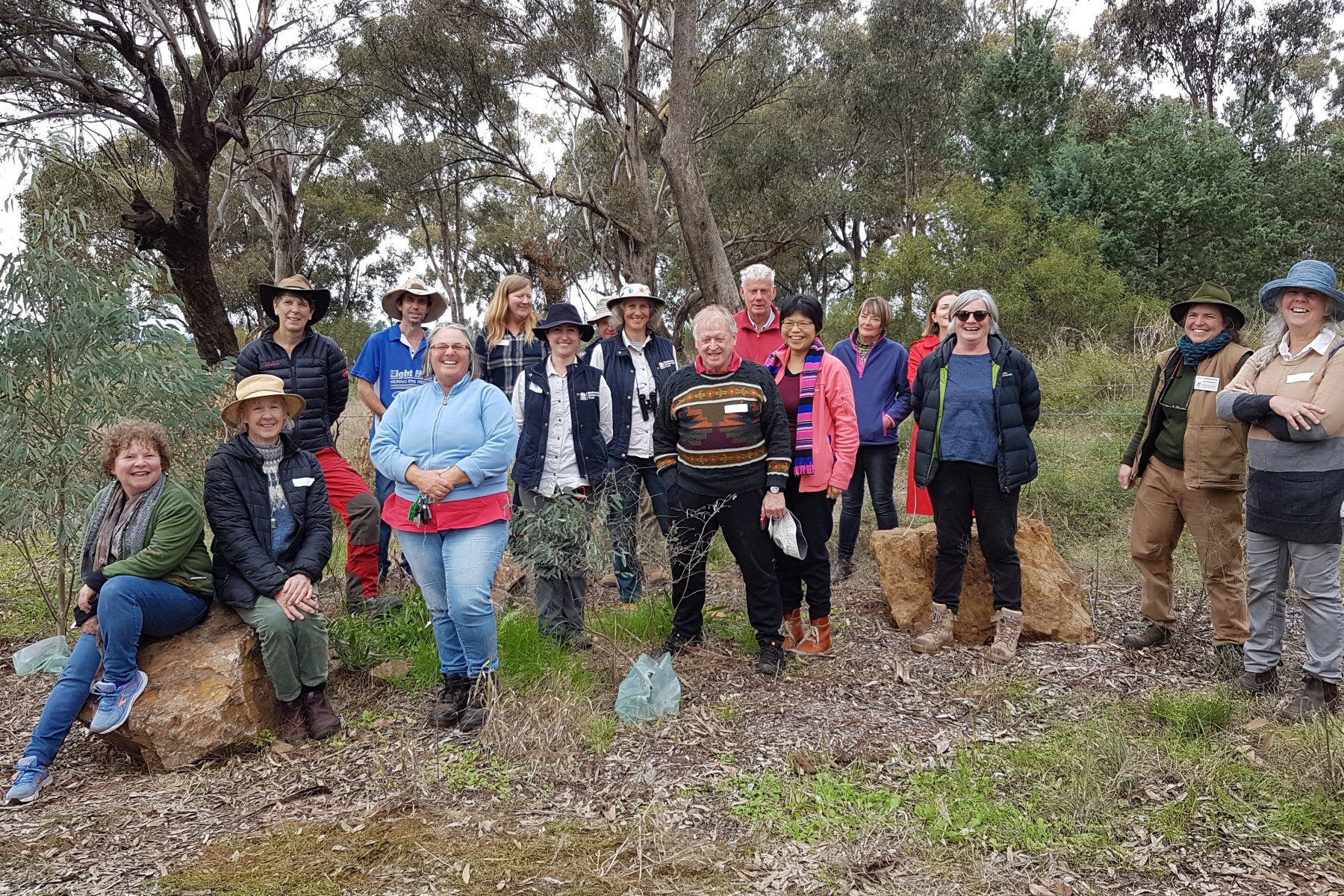
On Saturday the 21st May we held our first ever Fungi Surveys of Box Gum Grassy Woodlands on 2 sites around Cowra. One site was the Chiverton TSR on the Grenfell Rd. and the second site was in remnant woodland on the farm of one of our Box Gum Grassy Woodlands Habitat on Farm projects.
It will be wonderful to start gathering data on the fungi in our woodlands. We set up 4 teams on each site and collected 101 fungi specimens that have all gone to the Orange Ag Institute for official identification and recording.
In case you needed a bit of extra encouraging to love fungi, Alison Pouliot reported in this FungiMap BLOG about the fungi of Central Victoria’s Box Gum Woodlands and I am sure the same would be said for our local woodland here :-
Hundreds, possibly thousands of species of fungi inhabit Central Victoria’s Box-Gum Grassy Woodlands and Derived Grasslands. Although rarely a focus of biodiversity management, fungi are vitally important to the health and resilience of these ecosystems.
Many fungi may be threatened by processes that have resulted in widespread destruction or deterioration of these woodlands, especially as they are now largely restricted to isolated remnants.
It is so important for us to learn more about the fungi of these Woodlands to help us protect them into the future. The fungi are just as vital as the trees, understory, forbs, fallen timber and everything else associated with the woodlands. Interestingly it was noted by Alison that there was quite a difference in species when comparing the two sites. The species at our farm remnant site were very much colonising fungi species and although we found many fungi, it was not as diverse as the TSR (Travelling Stock Reserve) site. The TSR site also contained a greater variety of understory and groundcover plant species.
It really helped to tie the day together having some of the Biodiversity Conservation Trust team along to talk about the Box Gum Grassy Woodland remnants we were surveying in.
I am truly blown away everyday at how much everything links up with everything else. We still have such a small knowledge of this interconnectedness around us. They say Fungi is the Forgotten Kingdom but we are working to change this across the Central Tablelands. I can’t wait until next May!!!
The CSIRO did a study published in 2009 ‘Fungus diversity in revegetated paddocks compared with remnant woodland‘ in the area around Holbrook which is an interesting read if you wanted to have a look at it.
You can also check out this article recently produced by The Conversation ‘Beyond Flora and Fauna: Why it’s time to include fungi in global conservation goals‘ which further discusses the importance of fungi in our ecosystems and life.


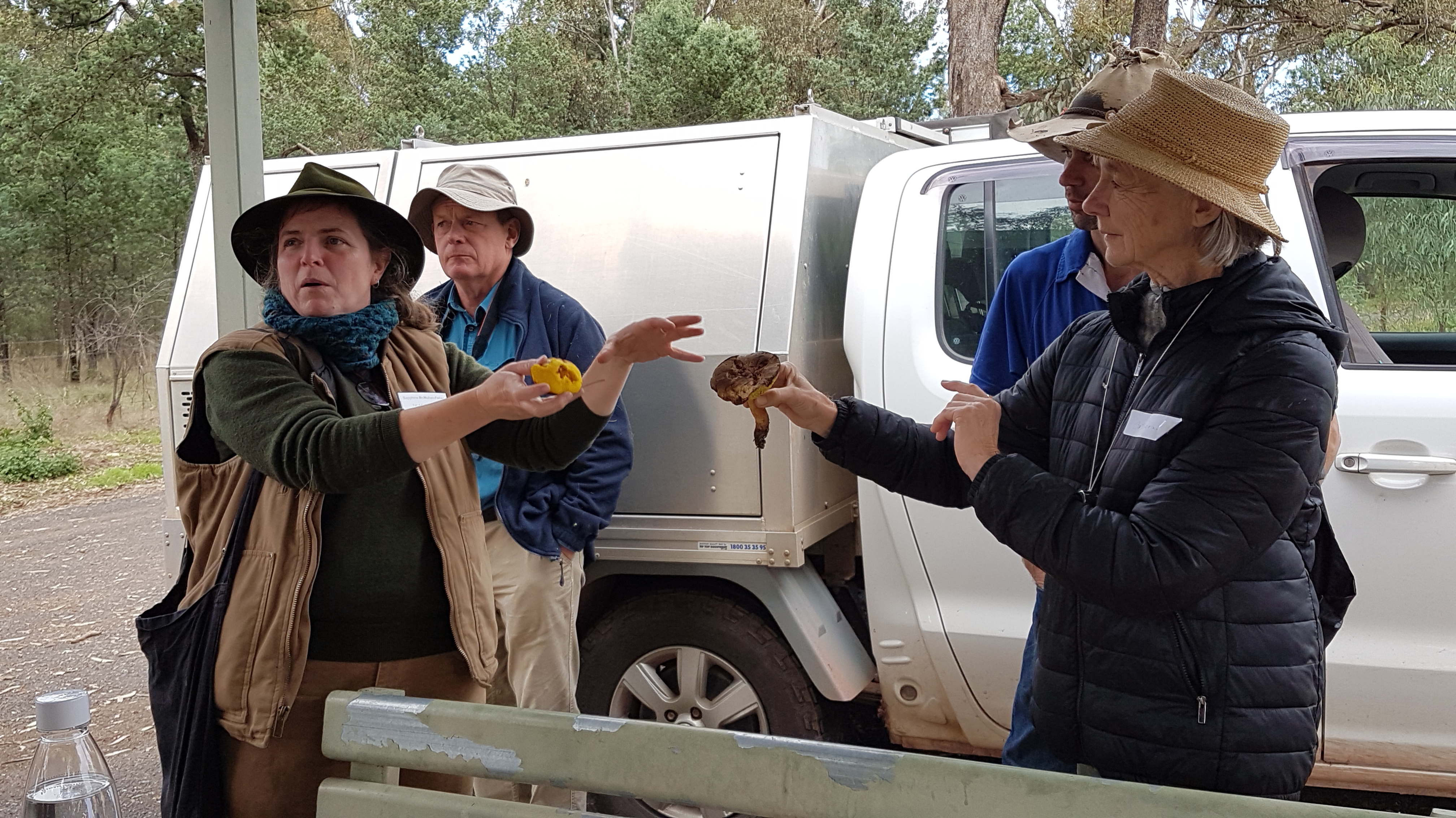


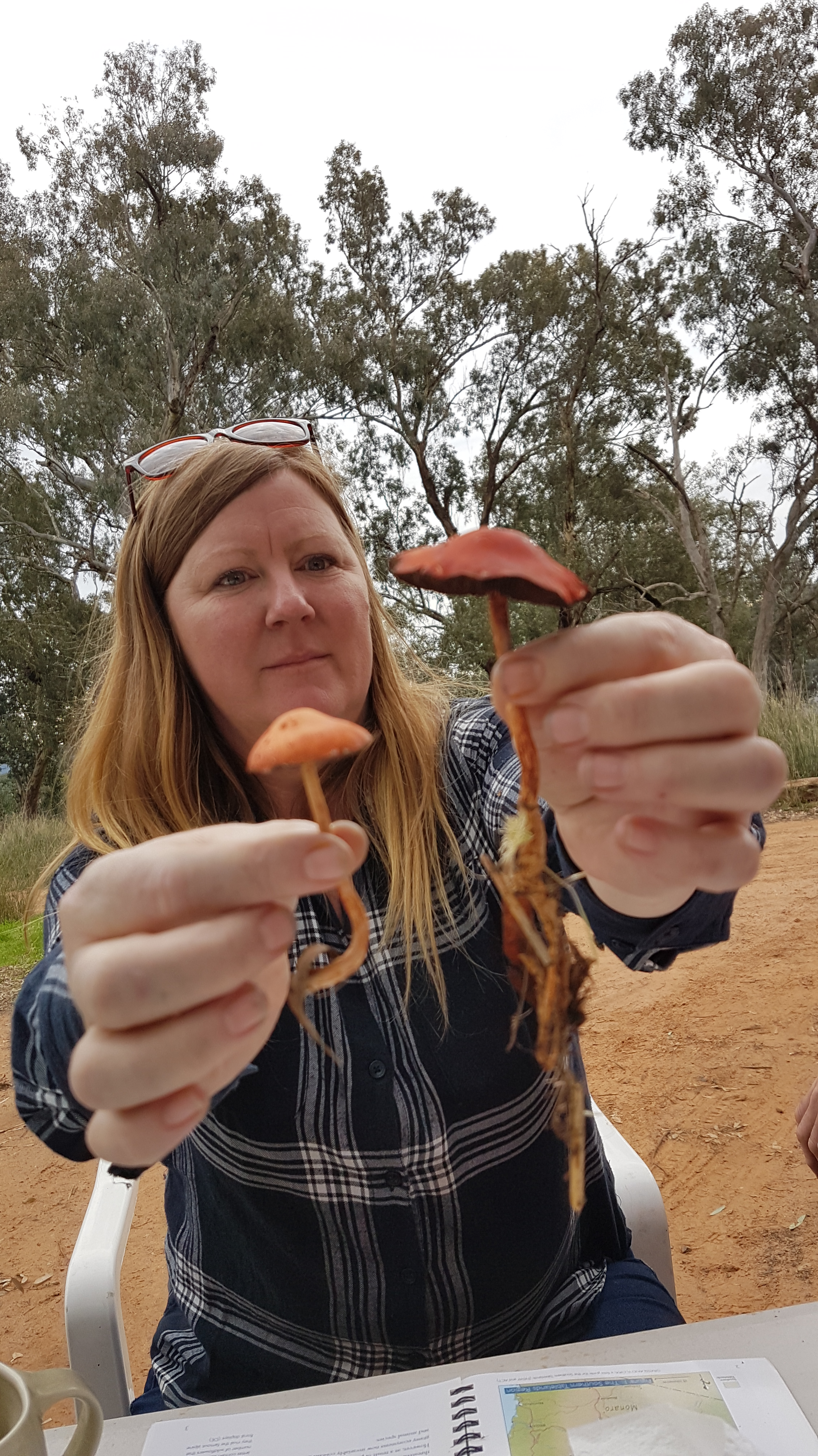





Special thanks goes to all the partners who helped to make this event possible. They include Central Tablelands Local Land Services, Saving our Species, the Environmental Trust and also the Biodiversity Conservation Trust.

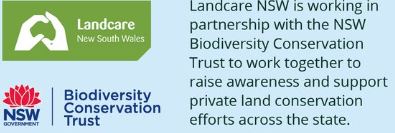


Listening to the Lachlan

By Trudi Refshauge (Note: this BLOG does not cover all conference topics and issues)
Listening to the Lachlan was a two-day conference, held in Forbes, 21st and 22nd June 2022, exploring social, economic, ecological, and cultural issues currently connecting to the Lachlan River.
Stakeholders from the Upper Lachlan (Reids Flat) to the lower Macquarie Marshes, joined irrigators, ecologists, engineers, graziers, first nations peoples, politicians, and government agents, offering facts, feelings, reports, and concerns about the Lachlan River.
Central West Lachlan Landcare, Mid-Lachlan Landcare, Lachlandcare and Hovells Creek Landcare sent representation.
The Issues (The following conference questions revealed several key issues)
Do more dams make more water? Is raising the Wyangala Dam wall robbing Peter to pay Paul? (e.g., will downstream farmers gain water security while upstream farmers lose their productive grazing lands?
Does Raising a Dam wall make sense, if it means drowning a critically threatened Grassy Box Woodland? (NOTE: 1 % of this ancient Eucalypt ecosystem remains in the Central West, having cleared most woodlands for agriculture).
The proposed Wyangala Dam wall upgrade will require a vehicle movement about every 33 seconds during the build, and every second vehicle will be a heavy truck. 875,000 truckloads of earth and gravel, equaling one truck every 18 minutes for four years. How will this effect local roads, or the people, livestock and native fauna that share the road?
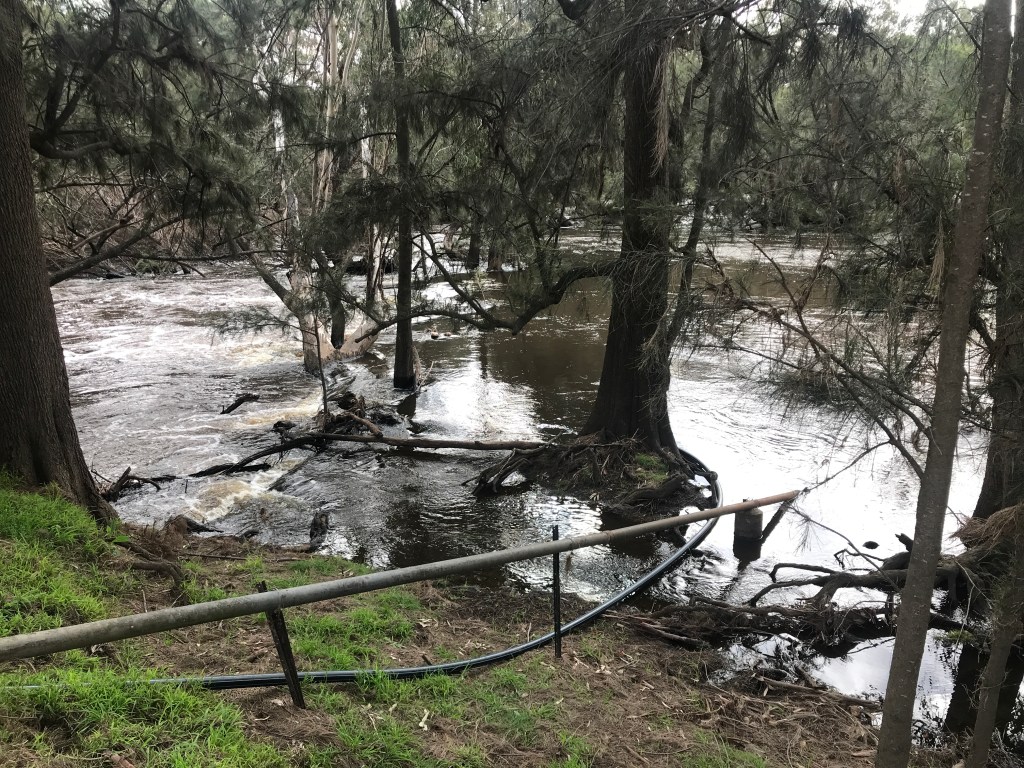

Will irrigating from the Lachlan River become more expensive than irrigating with bottled water? (A $2 billion upgrade = $30,000 per mega-litre).
Can the dam be managed for both flood and drought mitigation (meaning it will need to be kept full but have air-space at the same time)?
The Lachlan River’s catchment is disconnected from the Murray-Darling Basin. Has it missed out on critical funding for water efficiency programs and largely been forgotten by government?
How do we value ducks and native fish populations opposed to irrigation production systems?
How can The River’s connected flood plains and wetlands be maintained in a hotter, drying climate?
Country is currently and noticeably drying from the bottom up (small and medium size flood/flow events have stopped and major flow events are now smaller). The downstream floodplains have dried out since the 1971 raising of the Wyangala Dam wall, so what will happen if the wall is raised higher?
What effects has the decline of 71 % of water coming into the Great Cumbung swamp had on water birds (as water birds eat grass-hoppers, does bird loss contribute to pest plagues and ecosystem decline?
Has ‘The River’ become a (turbid and sand-clogged) pipeline for irrigators and towns as opposed to a once sacred common, offering clear water, food, and access to all?
Has the introduced system of trading water moved all the power to the high-end user and is this fair?
Australian National University researcher discussed Forbes railway line as contributing to existing flood problems for Forbes and suggested their were engineering solutions to mitigate this issue.
Cultural issues????
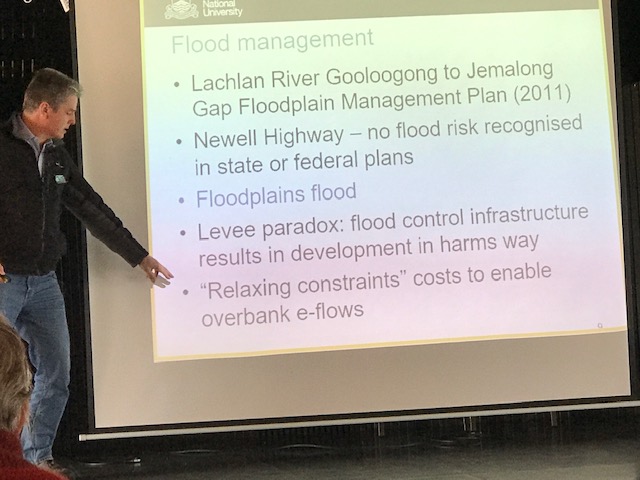

The Solutions
- Transfer costs of building Wyangala Dam wall to invest in alternative water security measures;
- Develop systems that both utilize groundwater and allow for full aquifer recharge
- Instill water treatment plants for towns to reuse and recycle storm and waste water
- Support irrigators to update and improve their water efficiency (e.g. pipelines)
- Allow more flows to flood plains allowing waterbirds and other native species to flourish
- Control all land erosion sites that contribute to the existing and growing sand slug
- Protect and restore a long-term water plan supporting people and food security as well as indigenous culture and ecological diversity (particularly protecting water bird and native fish breeding habitats).
Key Facts
- The Lachlan River is the 4th longest river system in Australia.
- It is the only river with a decreasing channel capacity, that terminates inland (into the Great Cumbung Swamp).
- There is a complex system of governance aligned to the River and its wetlands (independent rules exist for irrigators, towns and each of the following systems; Lake Cowal, Lake Brewster, The Great Cumbung Swamp, the Macquarie Marshes).
- There is currently an expanding 150-kilometre-long sand slug moving downstream from Wyangala Dam, filling and suffocating fish breeding holes, causing localized flooding beneath bridges, and becoming problematic to irrigators.
- Since 1971 (construction Wyangala Dam wall 2), Macquarie Marshes has flipped from being a wet, constantly flooded system to a dry, occasionally flooded system.
Concluding statement from Macquarie Marshes farmer Garry Hall
“Climate change is real and it’s here and we all need to Listen to the Lachlan to help it survive.”
A huge congratulations to Pennie Scott (a Canowindra local) who organised this special conference.
Glossy Update April 2022

There were a few of us that took part in the first annual Great Glossy Count last month and we surveyed grids in Conimbla NP, just outside Conimbla NP and over at Back Yamma State Park. The aim of the surveys were to look for Glossies and also to look for their feed trees. Unfortunately we did not see any Glossies but we certainly found feed trees in and around Conimbla. There were no feed trees recorded in Back Yamma unfortunately.
Jayden identified that the trash they drop while eating the seed at the sites varied in age from 2 to 4 weeks old. So fantastic to see the Glossies had been there recently. It will be so fantastic to have this data collected across Eastern Australia in their range. Hopefully it will help the birds into the future.

We have also recently collected some more of the trees that the Weddin Nursery have grown specifically for this project and they are being planted into some of the project sites. I have been told that the trees that went in last year are growing well too which is great news.
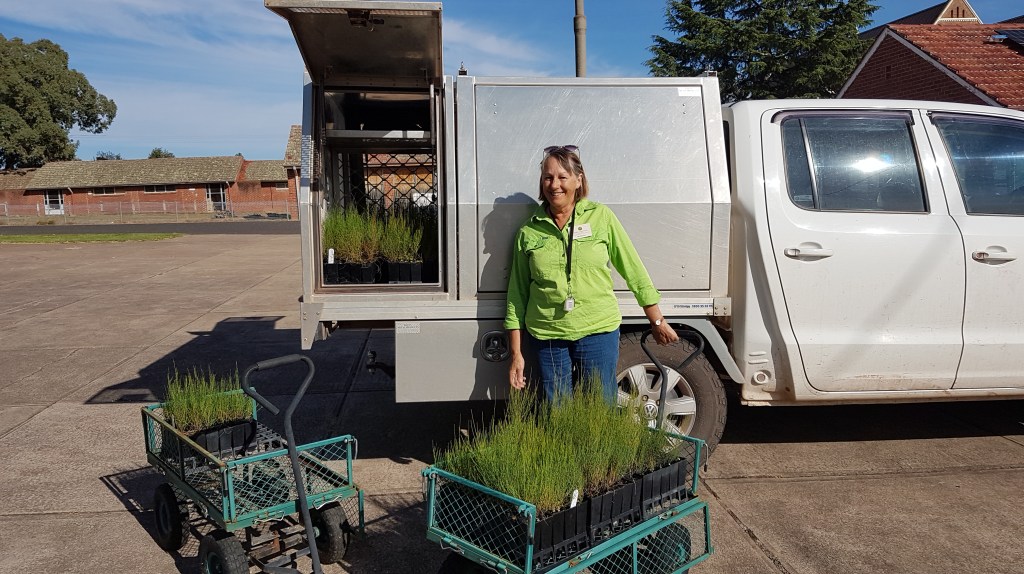


Rakali – a sad local story

Last weekend whilst walking along a a creek near Koorawatha one of our members came across some bailing twine tied to a log and trailing down into the creek. She decided to investigate what it was and wanted to let everyone know.
“I’ve had a sad experience over the weekend of getting my first Rakali sighting ever, unfortunately deceased in an opera house net. It appears to be a mother and offspring, based on sizes/sex etc – this was the cost of catching one small yabby. I can only hope there were other siblings around that are old enough to survive without the mother.
I thought it could now at least be something that can be shared among our Landcare network?
A reminder about the risks and impact of enclosed nets (legal or illegal), as some people really seem to forget why opera house nets are illegal to begin with, and the need to not submerge enclosed nets ……this one even had excluder rings on the entrances, so that’s also still not safe.
I thought it’s likely some people would think these were just exotic rats if they caught them too..”


Maybe you did not know that the opera house nets are now illegal as of the 30th April 2021. You can find out more here. New open top style yabbie nets are widely available and must be used instead to allow non target species to safely exit the traps. Please don’t use the closed in nets anymore.
You can also find out more about the wonderful Rakali (sometimes described as Australia’s otter) here.
Saving our Superb Parrot – Funding Available

Photo Credit – Phillip Weyers
We are excited to have a little bit more funding to continue the fantastic work everyone has been doing to put scattered paddock trees back into our farms. Planting trees, for the future, to help the Superb Parrot plus many other species in the long term. Some of the key threats to the Superb Parrot are the loss of living and dead hollow bearing trees and poor regeneration of nesting trees.
The aim of this funding is to build on the work done for this project in 2018/19. To enhance areas of our highly cleared landscape in the Mid Lachlan Landcare region by further developing connectivity through the landscape to improve movement and habitat of the Superb Parrot and other local fauna. The trees must be planted within 30m of each other and preferably connect remnants i.e., roadside vegetation and an existing mature paddock tree.
Most of you would now be very familiar with the paddock tree work and the mesh we have been using to construct the guards. The cost of this mesh and star pickets has increased significantly during the last 2 years. We can offer the trees plus 50% off the cost of the mesh and star pickets for this project. There are more details in the attached Expression of Interest (EOI). Construction and installation of the guards plus planting of tube stock is to be completed by you. Hopefully we will get a couple of farm depot offers again and will have tractors to load the mesh onto your vehicles when you are ready to collect.
We cannot give exact pricing until all EOI’s are received, assessed and prioritised. The current indication is that a 50% contribution by participants for one large roll of mesh and the pickets needed should work out to be about $450 and less for the shorter mesh rolls. (fingers crossed no more steel price rises in the meantime)
We really hope you would like to be part of this project. If you are not familiar with these tree guards or have any questions, please just give me a call and I can talk you through it.
You can find out more about the Superb Parrot Project and scattered paddock trees on our Website here You can also access a Mid Lachlan Landcare region map here.
Please feel free to forward this email to anyone in the region you think might also be interested in taking part in this project.
We are looking forward to receiving your expression of interest.
Funding Available – Box Gum Grassy Woodland Habitat on Farm

If you have some remnant woodland on your farm and would like to take some actions to protect or enhance it for the future, we would love to hear from you.
Some activities you might like to undertake could include :
- controlling weeds
- increasing woodland patch sizes and improving condition
- reconnecting fragmented remnant patches
- fencing off remnant patches to allow strategic grazing
- establishing appropriate grazing regimes to improve groundcover within a remnant area
- supplementary planting within the remnant area
- supplementing lost timber with other woody debris
We can provide funding to help with these activities if your remnant area is Box Gum Grassy Woodland. Don’t worry if you are unsure what type of remnant patch you have. Our project officer is more than happy to discuss with you and work it out.
To find out more about how to get involved please either send Tracee an email at midlachlanlandcare@gmail.com by the 30th of April 2022 and let her know you are interested. Please include your nearest town. Or you can give her a call on 0417 799 425.
White Box, Yellow Box, Blakely’s Red Gum Grassy Woodland is now listed as a critically endangered ecological community, and we can take actions on our farms to help it survive into the future. We are really looking forward to hearing from you and doing some awesome projects over the next 12 months.
This project has been made possible thanks to the NSW Government via the NSW Environmental Trust, the program is interested in collaboration between Government, the community, non-government organisations and industry.

Glossy Black Cockatoo Count – 26th March 2022

photo by Jayden Gunn
I was really excited to see this come up!! We love our Glossy Black Cockatoos and if this becomes a yearly event it will be great to be involved with considering the project we are currently running to plant the Allocasuarina diminuta’s on properties around Conimbla NP. I was lucky recently to hear and then see two of them on a property over near Canowindra.
There is an amazing new field guide just released by Birdlife Australia which includes some pictures taken by Cowra’s very own Jayden Gunn of Glossies from Conimbla 🙂 You can access the field guide here
The count is happening on Saturday 26th March and there is an online workshop happening on the 16th March at 7.30pm. It was easy to register and hopefully if there are a few of us doing it we could get a good picture of what is happening locally. I’m not sure how they are working out the sites so it will be a bit of a mystery for us (which adds to the excitement). Fingers crossed they are setting up some local sites.
To register and find out more you can pop over to the Glossy Black Cockatoo website here. The website also has heaps of other great info about Glossies. We would love it if you let us know if you have registered so we get a picture locally of who is interested.
OUR MEMBERSHIP – CASE STUDIES

By Trudi Refshauge
Meet some of our amazing Mid Lachlan Landcare Community. We will be adding more case studies throughout 2022.
Cowra Archibird Winners 2021

The Cowra Natural Resource Management Committee in partnership with the Cowra Woodland Bird Group and Mid Lachlan Landcare would like to thank everyone who entered the 3rd annual Archibird Competition. Pictured is the Open category winner, a Black Shouldered Kite by Chris Bruce. Judging was completed during November with all winners being contacted then. We are a bit slow getting this summary out but better late than never 🙂
Our wonderful judge John Cooper EFIAP FAPS had a difficult job and we are very thankful to him for taking on this task each year. Here is a summary from John.
” This, the third year of the Archibird Prize Photographic Competition was once again an outstanding success with the highest number of entrants so far. There were 225 entrants in the Open Category, 16 entrants in the Youth and 29 in the Teen category.
The standard of photography continues to improve which is evident by the marked increased number of ‘Commended’ and ‘Highly Commended’ awards issued. Congratulations to all the award winners. To those who missed out this year there is always next time! Carefully study the award winning images to see how you may improve your bird photography.
‘The Archibird Prize Competition looks for the best of the best in bird photography. First and foremost the images are judged for their photographic merit irrespective of how rare a bird species may be or how dramatic the action appears. Emphasis is placed on exposure, composition, focus and overall impact. Post capture editing (when/if done) is also taken into consideration. “
All the winning images (if you haven’t already seen them) can be viewed in the links below :
We can’t wait to see the entries for this year. The Archibird photo competition is held during the month of October so you all have plenty of time to get out and practice your bird photography skills 🙂



